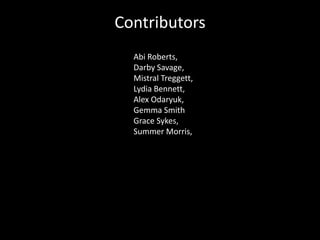A spowerpoint
Download as pptx, pdf0 likes164 views
This document lists the contributors to a student work project, including 8 students: Abi Roberts, Darby Savage, Mistral Treggett, Lydia Bennett, Alex Odaryuk, Gemma Smith, Grace Sykes, and Summer Morris.
1 of 10
Download to read offline










Ad
Recommended
Baudrillard & hyperreality
Baudrillard & hyperreality photographyatharlow
╠²
The document discusses Jean Baudrillard's concept of hyperreality and how living in a postmodern society influenced by mass media can distort our perception of reality. Baudrillard believed that media simulations of reality become so idealized that they surpass reality and influence how we see the world. This can lead to feeling that our real lives do not measure up to the artificial realities portrayed in media. The document uses examples like highly produced war coverage and advertisements to illustrate these concepts.Media langauage
Media langauagephotographyatharlow
╠²
This document discusses how meaning is constructed in media through the use of signs and symbols. It introduces concepts from semiotics such as the signifier/signified relationship and how denotation versus connotation influence audience interpretation. Various film and media theorists are mentioned who contribute to understanding how codes, conventions and organization of signs can encode particular messages. The document advises to analyze one's own media work by discussing specific examples of how micro-level elements like mise-en-scene, camerawork and editing were used to construct meaning and representation for the intended audience.Collectiveidentity intro
Collectiveidentity introphotographyatharlow
╠²
Collective identity refers to a sense of belonging to a group that transcends individual identity. Media representations can influence collective identity formation as audiences draw on media depictions to understand themselves and others. While early theories viewed audiences as passive, current research recognizes audiences as active in decoding and making meaning from media representations according to their own experiences. Identity is constructed through social interactions and media provides resources for thinking about oneself and possible lifestyles, though lived experiences have a stronger influence than media alone.Sectionb case
Sectionb casephotographyatharlow
╠²
The document discusses the film industry, including the key stages of production, distribution, and exhibition. It provides details on how films are financed through investors and the risks investors consider. Case studies of The Dark Knight and Shifty are examined in terms of their production, marketing, distribution, and how they navigated the film industry. The challenges of low-budget British films are also reviewed in comparison to big-budget Hollywood blockbusters.Sectionb case
Sectionb casephotographyatharlow
╠²
This document provides information about the film industry, including the processes of production, distribution, and exhibition. It discusses how films are financed through investors and the risks involved in film production. Case studies of The Dark Knight and Shifty are examined in terms of their production, distribution, marketing, and the challenges of low-budget filmmaking. The roles of institutions such as Warner Bros, Metrodome, the UK Film Council and BFI in the film industry are also summarized.G321evaluationtechniques
G321evaluationtechniquesphotographyatharlow
╠²
The document provides guidance for students on how to structure and present their responses to 7 questions evaluating their media production project. It recommends using a variety of presentation methods like PowerPoint, Word documents, videos, avatars, and websites. For each question, students should demonstrate their skills, keep responses concise, and include relevant examples, links and references to support their points. The questions address genre conventions, representation, target audience, marketing, technical skills learned, and improvements from preliminary work.Introduction to ci2
Introduction to ci2photographyatharlow
╠²
Representation involves interpreting reality and re-presenting it to an audience through media. All media goes through this mediation process of selecting what to show and how to show it. Representations are shaped by the opinions of their producers and the context of the society in which they are presented. Audience cultivation theory suggests that media representations have gradual, long-term effects on audiences by reinforcing social values.Model answer collective identity
Model answer collective identityphotographyatharlow
╠²
Collective identity refers to how people define themselves based on their group memberships. This document discusses media representations of young people and their influence on collective identity. It analyzes how historical films and TV shows often portrayed delinquent youth in a negative way that reinforced societal norms. Contemporary media still tends to represent youth negatively and in a way that increases the perception they need control. However, audiences can interpret media in different ways, and social media now allows young people more ability to construct their own representations and challenge dominant narratives. The future impact of media on collective identity likely depends on navigating the blurred lines between reality and hyperreality in a digital age.Baudrillard
Baudrillardphotographyatharlow
╠²
Jean Baudrillard was a French theorist who analyzed signs and symbols in culture. He believed that in postmodern society, signs and media no longer represent reality but instead create simulations and hyperreality that blur the lines between real and fictional. According to Baudrillard, we live in a world where signs reflect other signs and claims to reality are themselves artificial constructions. Contemporary media play a role in alienating us from the real world and reflecting the views of powerful groups through language and ideology. This has generated a spectacular simulated world that reality cannot match.Medialanguage
Medialanguagephotographyatharlow
╠²
This document provides an overview of media language and semiotics. It defines key terms like denotation and connotation, signifiers and signifieds. Semiotics is introduced as the study of signs and how they construct meaning. Roland Barthes expanded on this, arguing that media texts have denotative and connotative meanings and encode particular messages and ideologies. Examples are provided of analyzing signs and meanings in advertisements and media texts. The document stresses that meaning is interpreted and context is important. It encourages analyzing one's own media through this semiotic lens.Collective identities
Collective identities photographyatharlow
╠²
Collective identities provide a sense of inclusion and differentiation for individuals. They help people establish a positive self-concept through identification with and comparison between social groups. Collective identity refers to a group membership that shapes personal identity, and may even trump other aspects of personal identity at times. Through social activities and participation in groups, individuals gain a sense of belonging and identity beyond themselves.In his 2000 work
In his 2000 workphotographyatharlow
╠²
This document discusses how social media enabled communication networks that facilitated organization during the Egyptian uprising against Mubarak in 2011 and the London riots in 2011. It explores both the positive and negative ways social media can empower groups. On one hand, social media allows rapid information sharing that can help organize political resistance or criminal plans. However, it also lowers barriers to expression, creates opportunities for marginalized voices, and fosters social connections through participatory culture.Genretheory
Genretheoryphotographyatharlow
╠²
This document discusses genre theory and defines genres as groupings of texts that share conventions of content, form, themes, and style. While genres have common identifiable elements, the boundaries between genres are fluid as they evolve over time and individual texts can blend elements of multiple genres. Genres aid communication between creators and audiences by establishing expectations, but allow for new interpretations within traditional frameworks. Key components used to define genres include settings, characters, narratives, iconography, and stylistic elements.Mediatheoriesandtexts
Mediatheoriesandtextsphotographyatharlow
╠²
The document discusses several media theories related to the representation of social classes:
1) Gramsci's theory of cultural hegemony which holds that the middle class dominates society by presenting its values as normal and natural, with other classes accepting these values.
2) Theories that the media promotes the ideas of the ruling class to maintain this hegemony and distract/trap the working classes.
3) Gramsci also viewed hegemony as constantly struggling with alternative representations challenging dominant perceptions.
4) The document discusses applying these theories to analyze the representation of social classes in various media texts.1bnarrative
1bnarrativephotographyatharlow
╠²
This document discusses different theories and concepts related to narrative structure. It begins by distinguishing between a story and a narrative, with a story being the events and a narrative being how the story is told. It then covers various structural elements of narratives including genre, character, form, and time. Common narrative structures like linear, open and closed are defined. The document also summarizes theories from Roland Barthes, Vladimir Propp, Claude Levi-Strauss, Joseph Campbell, and Tzvetan Todorov on narrative codes, character types, binary oppositions, archetypes, and equilibrium models of narrative.1 b audience
1 b audiencephotographyatharlow
╠²
The document discusses theories of audience in media studies. It describes three main theories: the effects model which sees audiences as passive, the uses and gratifications model which sees audiences as active, and the reception model which examines how media texts are encoded and decoded. It also provides context on these theories and notes they were developed before modern media so may be outdated today.1brepresentation
1brepresentationphotographyatharlow
╠²
Representation refers to how media producers portray realities, people, places, and events to an audience through various creative and technical choices. All media goes through a process of mediation where the raw reality is interpreted and re-presented. Even reality television involves carefully selecting housemates, camera angles, and scenes to broadcast. Representations can be reflective of reality, intentional to convey a specific meaning, or constructionist by acknowledging how audiences may accept or reject what they see based on their own views. How people and groups are represented through media affects how they are seen and treated by society.Disney
Disneyphotographyatharlow
╠²
The Walt Disney Company started in 1923 as a small animation studio founded by Walt and Roy Disney in Hollywood. Today it is one of the largest media and entertainment corporations in the world, owning major film studios, television networks, parks and resorts. Disney produces films across many genres but is known for its animated films, live action films, and franchises. Its film production business includes Pixar Animation Studios and other major film studios.Semilogy
Semilogyphotographyatharlow
╠²
Semiology is the study of signs and how they construct meaning. It examines the relationship between the signifier, which is the sign in its basic form like a word or image, and the signified, which is the concept or meaning associated with the signifier. Signs can have both denotative meanings based on the literal definition as well as connotative meanings involving cultural associations. How signs are interpreted depends on one's cultural context. There are three types of signifiers: icons that resemble the signified, indexes that have a factual connection, and symbols where the connection is arbitrary like words representing concepts.Collectiveidentity
Collectiveidentityphotographyatharlow
╠²
This document discusses various theories related to media influence and representation, including cultivation theory, cultural effects theory, pluralism, hegemony, stereotypes, implicit personality theory, social identity theory, and countertypes. It provides definitions and perspectives from theorists such as George Gerbner, Henry Giroux, Stanley Cohen, Richard Dyer, and Henri Tajfel on how media representations can influence audiences and society over time through reinforcement of dominant ideologies and social norms.G325 narrative
G325 narrativephotographyatharlow
╠²
This document analyzes the student's coursework production in relation to the concept of narrative. The production was an opening title sequence for a film about a teenage girl who escapes her boring life through writing. To develop the narrative, the student conducted research on teenagers' desires and dislikes, which informed the protagonist's loneliness. Minimal human contact and a voiceover were used to convey this. The student composed original music to set the mood and filmed mostly at a school to reflect teenage life. Feedback was incorporated throughout production to improve the narrative and ensure the genre and protagonist's vulnerability came across clearly without confusing the audience.G325 1a resesearch and planning
G325 1a resesearch and planningphotographyatharlow
╠²
The candidate developed research and planning skills over time that contributed to their media productions. For a music magazine, they conducted semiotic analysis of existing magazines to identify codes and conventions. They also did quantitative and qualitative research through interviews and an online survey to determine what to include. This informed a preliminary magazine design in Photodraw and a final planning sheet. For a music video, the candidate created storyboards and schedules and a preliminary video in iMovie to plan shots and learn video skills. Reflection on earlier methods helped research and plan a subsequent project more efficiently, applying lessons learned.G325 collective dentity
G325 collective dentityphotographyatharlow
╠²
1) The document analyzes how different media represent immigrants in Britain and the impact this has on collective identity.
2) It discusses the video "My tram experience" which went viral in 2010 and showed a woman expressing racist views towards an immigrant on a tram. The video demonstrated theories that blackness and Britishness are seen as mutually exclusive.
3) Newspapers in the 1960s generally took a balanced approach to representation, but contemporary newspapers tend to follow a hegemonic approach and reduce complex issues to simple explanations that blame problems on immigrants.
4) While some films from the 1950s and 2000s presented pluralistic representations of immigrants, they did not receive wide attention. Music like Grime musicG322 q2 music
G322 q2 musicphotographyatharlow
╠²
Sony Corporation owns 33% of the global music market and various music labels, giving it ownership over much of the music it represents. As a large conglomerate, Sony has the financial backing to profit greatly from popular artists but pays those artists a smaller percentage than smaller independent labels. Independent label A Wolf at Your Door, which owns only a small portion of the global market, struggles due to widespread illegal downloading eroding its profits, forcing it to rely on concerts and merchandise for revenue. It was even forced to sell ownership of one of its most profitable bands to Sony. While digital technologies have benefited independent labels by allowing them to reach global audiences more affordably, widespread illegal downloading has also blurred ownership of music in ways that damageCollective identity
Collective identityphotographyatharlow
╠²
This document discusses various theories related to media influence and representation, including cultivation theory, cultural effects theory, pluralism, and representation. It also covers concepts like ideology, hegemony, mediation, moral panics, stereotypes, implicit personality theory, social categorization, and countertypes. Several theorists are mentioned who contributed to understanding these concepts, such as Gerbner, Althusser, and Dyer.Collective identity
Collective identityphotographyatharlow
╠²
This document discusses several theories related to media influence and representation, including cultivation theory, cultural effects theory, pluralism, hegemony, and stereotypes. Cultivation theory proposes that television has small, gradual effects in reinforcing dominant societal ideologies. Cultural effects theory similarly argues that constant media exposure can subtly affect judgments over time. Pluralism posits that media merely reflect popular consensus values. Hegemony refers to the dominant classes using media to define societal norms. Stereotypes oversimplify groups using exaggerated or distorted characteristics.Synergyandcrossmediaconvergence
Synergyandcrossmediaconvergencephotographyatharlow
╠²
Large media conglomerates like Sony are able to benefit more from synergy and cross media convergence due to their size and ownership of multiple divisions. They can simultaneously release related media products from their film, music, and electronics divisions to promote each other. In contrast, smaller independent companies have fewer related products and divisions to utilize synergy and cross media convergence, putting them at a competitive disadvantage compared to large conglomerates.Sectionbaudiences
Sectionbaudiences photographyatharlow
╠²
The document discusses key aspects of the film industry process including production, distribution, and exhibition. It explains that production involves pre-production, production, and post-production. Distribution involves marketing and getting copies of films to exhibitors, who then show the films to audiences in cinemas or homes. The film industry aims to achieve synergy across production, distribution, and related products through various forms of ownership models and convergence.More Related Content
More from photographyatharlow (20)
Baudrillard
Baudrillardphotographyatharlow
╠²
Jean Baudrillard was a French theorist who analyzed signs and symbols in culture. He believed that in postmodern society, signs and media no longer represent reality but instead create simulations and hyperreality that blur the lines between real and fictional. According to Baudrillard, we live in a world where signs reflect other signs and claims to reality are themselves artificial constructions. Contemporary media play a role in alienating us from the real world and reflecting the views of powerful groups through language and ideology. This has generated a spectacular simulated world that reality cannot match.Medialanguage
Medialanguagephotographyatharlow
╠²
This document provides an overview of media language and semiotics. It defines key terms like denotation and connotation, signifiers and signifieds. Semiotics is introduced as the study of signs and how they construct meaning. Roland Barthes expanded on this, arguing that media texts have denotative and connotative meanings and encode particular messages and ideologies. Examples are provided of analyzing signs and meanings in advertisements and media texts. The document stresses that meaning is interpreted and context is important. It encourages analyzing one's own media through this semiotic lens.Collective identities
Collective identities photographyatharlow
╠²
Collective identities provide a sense of inclusion and differentiation for individuals. They help people establish a positive self-concept through identification with and comparison between social groups. Collective identity refers to a group membership that shapes personal identity, and may even trump other aspects of personal identity at times. Through social activities and participation in groups, individuals gain a sense of belonging and identity beyond themselves.In his 2000 work
In his 2000 workphotographyatharlow
╠²
This document discusses how social media enabled communication networks that facilitated organization during the Egyptian uprising against Mubarak in 2011 and the London riots in 2011. It explores both the positive and negative ways social media can empower groups. On one hand, social media allows rapid information sharing that can help organize political resistance or criminal plans. However, it also lowers barriers to expression, creates opportunities for marginalized voices, and fosters social connections through participatory culture.Genretheory
Genretheoryphotographyatharlow
╠²
This document discusses genre theory and defines genres as groupings of texts that share conventions of content, form, themes, and style. While genres have common identifiable elements, the boundaries between genres are fluid as they evolve over time and individual texts can blend elements of multiple genres. Genres aid communication between creators and audiences by establishing expectations, but allow for new interpretations within traditional frameworks. Key components used to define genres include settings, characters, narratives, iconography, and stylistic elements.Mediatheoriesandtexts
Mediatheoriesandtextsphotographyatharlow
╠²
The document discusses several media theories related to the representation of social classes:
1) Gramsci's theory of cultural hegemony which holds that the middle class dominates society by presenting its values as normal and natural, with other classes accepting these values.
2) Theories that the media promotes the ideas of the ruling class to maintain this hegemony and distract/trap the working classes.
3) Gramsci also viewed hegemony as constantly struggling with alternative representations challenging dominant perceptions.
4) The document discusses applying these theories to analyze the representation of social classes in various media texts.1bnarrative
1bnarrativephotographyatharlow
╠²
This document discusses different theories and concepts related to narrative structure. It begins by distinguishing between a story and a narrative, with a story being the events and a narrative being how the story is told. It then covers various structural elements of narratives including genre, character, form, and time. Common narrative structures like linear, open and closed are defined. The document also summarizes theories from Roland Barthes, Vladimir Propp, Claude Levi-Strauss, Joseph Campbell, and Tzvetan Todorov on narrative codes, character types, binary oppositions, archetypes, and equilibrium models of narrative.1 b audience
1 b audiencephotographyatharlow
╠²
The document discusses theories of audience in media studies. It describes three main theories: the effects model which sees audiences as passive, the uses and gratifications model which sees audiences as active, and the reception model which examines how media texts are encoded and decoded. It also provides context on these theories and notes they were developed before modern media so may be outdated today.1brepresentation
1brepresentationphotographyatharlow
╠²
Representation refers to how media producers portray realities, people, places, and events to an audience through various creative and technical choices. All media goes through a process of mediation where the raw reality is interpreted and re-presented. Even reality television involves carefully selecting housemates, camera angles, and scenes to broadcast. Representations can be reflective of reality, intentional to convey a specific meaning, or constructionist by acknowledging how audiences may accept or reject what they see based on their own views. How people and groups are represented through media affects how they are seen and treated by society.Disney
Disneyphotographyatharlow
╠²
The Walt Disney Company started in 1923 as a small animation studio founded by Walt and Roy Disney in Hollywood. Today it is one of the largest media and entertainment corporations in the world, owning major film studios, television networks, parks and resorts. Disney produces films across many genres but is known for its animated films, live action films, and franchises. Its film production business includes Pixar Animation Studios and other major film studios.Semilogy
Semilogyphotographyatharlow
╠²
Semiology is the study of signs and how they construct meaning. It examines the relationship between the signifier, which is the sign in its basic form like a word or image, and the signified, which is the concept or meaning associated with the signifier. Signs can have both denotative meanings based on the literal definition as well as connotative meanings involving cultural associations. How signs are interpreted depends on one's cultural context. There are three types of signifiers: icons that resemble the signified, indexes that have a factual connection, and symbols where the connection is arbitrary like words representing concepts.Collectiveidentity
Collectiveidentityphotographyatharlow
╠²
This document discusses various theories related to media influence and representation, including cultivation theory, cultural effects theory, pluralism, hegemony, stereotypes, implicit personality theory, social identity theory, and countertypes. It provides definitions and perspectives from theorists such as George Gerbner, Henry Giroux, Stanley Cohen, Richard Dyer, and Henri Tajfel on how media representations can influence audiences and society over time through reinforcement of dominant ideologies and social norms.G325 narrative
G325 narrativephotographyatharlow
╠²
This document analyzes the student's coursework production in relation to the concept of narrative. The production was an opening title sequence for a film about a teenage girl who escapes her boring life through writing. To develop the narrative, the student conducted research on teenagers' desires and dislikes, which informed the protagonist's loneliness. Minimal human contact and a voiceover were used to convey this. The student composed original music to set the mood and filmed mostly at a school to reflect teenage life. Feedback was incorporated throughout production to improve the narrative and ensure the genre and protagonist's vulnerability came across clearly without confusing the audience.G325 1a resesearch and planning
G325 1a resesearch and planningphotographyatharlow
╠²
The candidate developed research and planning skills over time that contributed to their media productions. For a music magazine, they conducted semiotic analysis of existing magazines to identify codes and conventions. They also did quantitative and qualitative research through interviews and an online survey to determine what to include. This informed a preliminary magazine design in Photodraw and a final planning sheet. For a music video, the candidate created storyboards and schedules and a preliminary video in iMovie to plan shots and learn video skills. Reflection on earlier methods helped research and plan a subsequent project more efficiently, applying lessons learned.G325 collective dentity
G325 collective dentityphotographyatharlow
╠²
1) The document analyzes how different media represent immigrants in Britain and the impact this has on collective identity.
2) It discusses the video "My tram experience" which went viral in 2010 and showed a woman expressing racist views towards an immigrant on a tram. The video demonstrated theories that blackness and Britishness are seen as mutually exclusive.
3) Newspapers in the 1960s generally took a balanced approach to representation, but contemporary newspapers tend to follow a hegemonic approach and reduce complex issues to simple explanations that blame problems on immigrants.
4) While some films from the 1950s and 2000s presented pluralistic representations of immigrants, they did not receive wide attention. Music like Grime musicG322 q2 music
G322 q2 musicphotographyatharlow
╠²
Sony Corporation owns 33% of the global music market and various music labels, giving it ownership over much of the music it represents. As a large conglomerate, Sony has the financial backing to profit greatly from popular artists but pays those artists a smaller percentage than smaller independent labels. Independent label A Wolf at Your Door, which owns only a small portion of the global market, struggles due to widespread illegal downloading eroding its profits, forcing it to rely on concerts and merchandise for revenue. It was even forced to sell ownership of one of its most profitable bands to Sony. While digital technologies have benefited independent labels by allowing them to reach global audiences more affordably, widespread illegal downloading has also blurred ownership of music in ways that damageCollective identity
Collective identityphotographyatharlow
╠²
This document discusses various theories related to media influence and representation, including cultivation theory, cultural effects theory, pluralism, and representation. It also covers concepts like ideology, hegemony, mediation, moral panics, stereotypes, implicit personality theory, social categorization, and countertypes. Several theorists are mentioned who contributed to understanding these concepts, such as Gerbner, Althusser, and Dyer.Collective identity
Collective identityphotographyatharlow
╠²
This document discusses several theories related to media influence and representation, including cultivation theory, cultural effects theory, pluralism, hegemony, and stereotypes. Cultivation theory proposes that television has small, gradual effects in reinforcing dominant societal ideologies. Cultural effects theory similarly argues that constant media exposure can subtly affect judgments over time. Pluralism posits that media merely reflect popular consensus values. Hegemony refers to the dominant classes using media to define societal norms. Stereotypes oversimplify groups using exaggerated or distorted characteristics.Synergyandcrossmediaconvergence
Synergyandcrossmediaconvergencephotographyatharlow
╠²
Large media conglomerates like Sony are able to benefit more from synergy and cross media convergence due to their size and ownership of multiple divisions. They can simultaneously release related media products from their film, music, and electronics divisions to promote each other. In contrast, smaller independent companies have fewer related products and divisions to utilize synergy and cross media convergence, putting them at a competitive disadvantage compared to large conglomerates.Sectionbaudiences
Sectionbaudiences photographyatharlow
╠²
The document discusses key aspects of the film industry process including production, distribution, and exhibition. It explains that production involves pre-production, production, and post-production. Distribution involves marketing and getting copies of films to exhibitors, who then show the films to audiences in cinemas or homes. The film industry aims to achieve synergy across production, distribution, and related products through various forms of ownership models and convergence.A spowerpoint
- 10. Contributors Abi Roberts, Darby Savage, Mistral Treggett, Lydia Bennett, Alex Odaryuk, Gemma Smith Grace Sykes, Summer Morris,